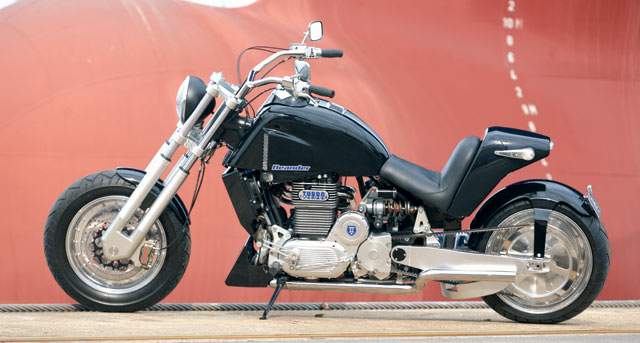 Read more about this motorcycle. Specification, detail, pictures and video. Please comments and give rating, tell others about it. Feel free to look around, we open 24 hours a day.
Read more about this motorcycle. Specification, detail, pictures and video. Please comments and give rating, tell others about it. Feel free to look around, we open 24 hours a day.
Make ModelNeander Diesel
Year:
Engine:
Capacity: 1340
Bore x Stroke: 105 x 77,6 mm
Compression Ratio:
Induction:
Ignition / Starting:
Max Power: 112 PS @ 4200 rpm
Max Torque: 214 Nm @ 2600 rpm
Transmission / Drive:
Front Suspension:
Rear Suspension:
Front Brakes:
Rear Brakes:
Front Tire: :
Rear Tire: :
Seat Height650 mm
Weight: 295 kg
Fuel Capacity: 14 Litres
ReviewsNeander-motor.com / Motorbox / Motorcyclecruiser.com / motoua.net / 1000ps
For those who don’t particularly like the 190bhp Kawasaki ZZR1400, Neander have the perfect solution – a motorcycle fitted with a high-tech 1.4-litre diesel Engine: . No, really, the Neander 1400 is fitted with a 1340cc, air-and-oil cooled, eight-valve, turbocharged, fuel-injected parallel-twin that makes around 95 horsepower at 4200rpm.
And before you GSX-R1000 and R1 owners start laughing, get this – the intercooled Neander mill makes 195Nm of torque at only 2600rpm, which is about twice as much of what most litre-class superbikes make. The belt-driven Neander, with its six-speed gearbox, accelerates from zero to 100km/h in 4.5 seconds, and top sped is 225km/h. So, yeah, this 270-kilo machine really is the oil-burner from hell…
We had already said most of what’s above, here, back in September last Year: . Now, the big news is that the Neander 1400 Turbodiesel is finally available all over Europe, for the equivalent of a mere US$140,000. Only 60 bikes will be made every Year: .
When Sir Alan Cathcart tested the Neander for Motorcycle Cruiser magazine, he said ‘The only downside to this thoroughly avant-garde diesel Engine: package is the noise it makes, which frankly isn’t very pleasant. The issue isn’t so much about the Engine: itself being mechanically noisy, more that the turbodiesel tune simply isn’t one that sounds at all melodic or even very sophisticated when you’re actually riding it, especially compared to conventional bikes costing one-tenth of the Neander’s heady sticker price.’
‘Diesel technology has advanced so much in the past 10 Year: s, not only thanks to turbocharging, but also due to variable nozzle geometry, and especially the evolution of the common rail system, such as found on the Neander. By any standards, this bike is a surprise – not only for its unique mechanical format, but also for the effective manner in which it applies the benefits of diesel development to a motorcycle,’ says Mr Cathcart.
Source Faster and faster